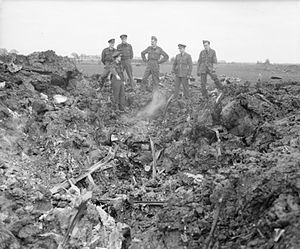
Back عملية شتاينبوك Arabic Unternehmen Steinbock German Opération Steinbock French Operación Steinbock Galician Operazione Steinbock Italian Operação Steinbock Portuguese
| Operation Steinbock | |||||||
|---|---|---|---|---|---|---|---|
| Part of World War II | |||||||
 Air Marshal Sir Roderic Hill inspects the wreckage of a Junkers Ju 188 E-1 belonging to 2. Staffel Kampfgeschwader 6 (Bomber Wing 6) which crashed in Shopland, Essex, 21 March 1944. | |||||||
| |||||||
| Belligerents | |||||||
|
|
| ||||||
| Commanders and leaders | |||||||
| Strength | |||||||
| c. 25 squadrons | 524 bombers[2] | ||||||
| Casualties and losses | |||||||
|
Aircraft 1,556 civilians killed |
Aircraft
| ||||||
Operation Steinbock or Operation Capricorn (German: Unternehmen Steinbock), sometimes called the Baby Blitz or Little Blitz, was a strategic bombing campaign by the German Air Force (the Luftwaffe) during the Second World War. It targeted southern England and lasted from January to May 1944. Steinbock was the last strategic air offensive by the German bomber arm during the conflict.
In late 1943, the Allied Combined Bomber Offensive was gathering momentum against Germany. The Allied air forces were conducting a strategic bombing campaign day and night against German industrial cities. In retaliation, Adolf Hitler ordered the Luftwaffe to prepare a bombing operation against the United Kingdom. The bombing offensive also served as propaganda value for the German public and domestic consumption. The operation ran parallel to Bomber Command's campaign against Berlin (November 1943 – March 1944).
The Luftwaffe assembled 474 bomber aircraft for the offensive. The attacks were mainly aimed at and around the Greater London area. In Britain, it was known as the Baby Blitz due to the much smaller scale of operations compared to the Blitz, the campaign against the United Kingdom in 1940–1941.[2] The operation began in January and ended in May 1944. It achieved very little, and the German force suffered a loss of some 329 machines during the five months of operations before it was abandoned. Casualties were at 70% for the planes committed and were destroyed at an average rate of 77 per month.
Eventually, the revenge attacks gave way to attempts to disrupt preparations for the impending Allied invasion of France, but Steinbock had worn down the offensive power of the Luftwaffe to the extent it could not mount any significant counterattacks when the invasion began on 6 June 1944.[4] The offensive was the last large-scale bombing campaign against England using conventional aircraft, and thenceforth only the V-1 flying bomb and V-2 rockets – the pioneering examples of cruise missiles and short-range ballistic missiles respectively – were used to strike British cities.[5]
- ^ a b Boog, Krebs & Vogel 2001, p. 379.
- ^ a b Boog, Krebs & Vogel 2001, p. 377.
- ^ a b c d Mackay 2011, pp. 427–430.
- ^ Boog, Krebs & Vogel 2008, p. 420.
- ^ Boog, Krebs & Vogel 2001, p. 380.